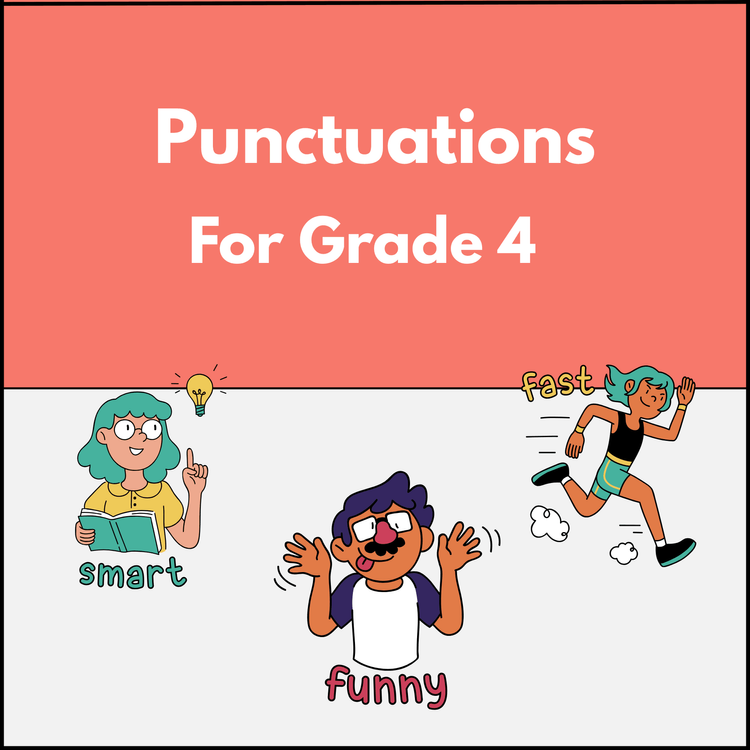Punctuation for Class 6: Rules, Types, Examples and More!

Punctuation is an essential part of English grammar. It helps make writing clear, precise, and easy to understand. For Class 6 students, mastering punctuation is a key step in improving both writing and reading skills. Correct punctuation not only gives meaning to sentences but also makes communication effective.
In this blog, we will cover everything students need to know about punctuation for Class 6, types of punctuation marks, rules, examples, and practical exercises. We will also provide a punctuation worksheet for Class 6 to help students practice and strengthen their skills.
Understanding Punctuation for Class 6
Punctuation is the set of marks used in writing to separate sentences, clarify meaning, and express emotions. For Class 6 students, understanding punctuation for Class 6 is an essential step in learning how to write clearly and effectively. Without punctuation, sentences can become confusing, and the meaning of your writing can be misinterpreted.
Punctuation marks act like signposts in a sentence. They tell the reader where to pause, when a statement ends, when a question is being asked, or when someone is speaking. For example, compare these two sentences:
- Lets eat grandma.
- Let’s eat, grandma.
The comma in the second sentence changes the meaning completely, showing the importance of proper punctuation.
By understanding punctuation, students can:
- Communicate ideas clearly
- Show emotions and tone in writing
- Improve reading comprehension
- Write essays, stories, and speeches correctly

Start Your Child’s Grammar Journey with PlanetSpark by booking a free, no-obligation demo class.
Types of Punctuation for Class 6
Punctuation marks are essential tools in writing. They help us organize our thoughts, make sentences meaningful, and communicate clearly. For Class 6 students, understanding the different types of punctuation for Class 6 is crucial for writing essays, stories, and even preparing for exams. Let’s explore the most common punctuation marks with detailed explanations and examples:
1. Full Stop (.)
The full stop is one of the most basic punctuation marks. It is used at the end of a declarative sentence—a sentence that makes a statement or provides information. Using a full stop tells the reader that the idea is complete and it’s time to pause before moving to the next sentence.
Example:
- The cat is sleeping.
- I enjoy reading books every evening.
Full stops are also used in abbreviations such as Dr., Mr., Mrs., a.m., and p.m.
2. Comma (,)
The comma is a versatile punctuation mark used to separate items in a list, clauses, or extra information. Commas help avoid confusion and make sentences easier to read.
Examples:
- I bought apples, bananas, and oranges.
- After school, I went to the library.
- My friend, who is very kind, helped me with my homework.
Commas are also used after introductory words like however, moreover, and therefore to clarify the flow of a sentence.
3. Question Mark (?)
A question mark is used at the end of a sentence to indicate a direct question. It signals to the reader that an answer or response is expected.
Example:
- Where are you going?
- Have you finished your homework?
It is important not to confuse a question mark with other punctuation marks, as it changes the meaning of a sentence. For instance:
- You are coming. (statement)
- You are coming? (question)
4. Exclamation Mark (!)
Exclamation marks are used to show strong emotions, surprise, excitement, or urgency. They make sentences more expressive and engaging.
Examples:
- Wow! That was amazing!
- Ouch! That really hurts!
- Hurray! We won the game!
Exclamation marks should be used sparingly in formal writing, but they are very effective in stories, letters, or dialogues to convey emotions.
5. Apostrophe (')
The apostrophe has two main uses: contractions and possession.
- Contractions shorten two words into one, showing that some letters have been omitted.
Example: It’s raining outside. (It is raining) - Possession shows that something belongs to someone.
Example: This is Rahul’s book.
Apostrophes are also used in plural forms of letters or symbols, such as:
- Mind your p’s and q’s.
6. Quotation Marks (“ ”)
Quotation marks are used to enclose direct speech, quotations, or titles of short works. They help distinguish someone’s words from the rest of the text.
Example:
- She said, “I love reading books.”
- “Can you help me?” asked Riya.
Quotation marks are often combined with commas, question marks, or exclamation marks to show proper punctuation within dialogue.
See How Fun Learning Grammar Can Be
Schedule a demo class for Class 6 students now.
7. Colon (:)
A colon is used to introduce lists, explanations, or examples. It signals that more information is coming after a complete statement.
Example:
- I need three things: a pen, a notebook, and an eraser.
- Remember the rule: Always be honest in your actions.
Colons are also used in formal writing, such as in time (5:30 p.m.) or ratios (1:2).
8. Semicolon (;)
The semicolon connects closely related sentences or separates items in a list that already contain commas. It helps avoid confusion and shows a stronger pause than a comma but less than a full stop.
Examples:
- I went to Delhi; my brother stayed in Mumbai.
- We invited my parents, who live nearby; my grandparents, who live in Pune; and my cousins.
Semicolons are often used in complex sentences where clarity is needed.
9. Parentheses (())
Parentheses, or round brackets, are used to add extra information, explanations, or clarifications. The sentence should still make sense if the parentheses are removed.
Example:
- I visited Paris (the capital of France) last year.
- My dog (who is very playful) loves to chase balls.
Parentheses help provide additional details without interrupting the main flow of a sentence.
10. Hyphen (-) and Dash (–)
- Hyphen (-): Joins words or parts of words to create compound words.
Example: well-known author, mother-in-law - Dash (–): Indicates a pause, break in thought, or adds emphasis.
Example: I wanted to go—but it was too late.
Hyphens are often used in spelling, while dashes are more common in narrative writing to add drama or explanation.
11. Ellipsis (…)
Ellipsis is used to show a pause, unfinished thought, or suspense. It can create mystery in writing or indicate that something has been left out intentionally.
Example:
- I was going to tell you… but I forgot.
- She looked around and whispered, “I can’t believe it…”
Ellipses are especially common in storytelling and dialogue to maintain suspense.
Why Punctuation is Important
Punctuation is like a set of signals in writing. Just like traffic signals guide drivers, punctuation marks guide readers to understand the meaning of a sentence correctly. Without punctuation, sentences can become confusing and unclear.
Some reasons why punctuation is important for Class 6 students include:
Clarifies meaning: Punctuation marks separate ideas and give meaning to sentences.
Expresses emotions and tone: Exclamation marks, question marks, and ellipses help convey feelings.
Improves readability: Proper punctuation makes writing easier to read and understand.
Enhances academic performance: Correct punctuation is essential in exams, assignments, and creative writing.
Builds confidence in communication: Students can write and speak clearly when they understand punctuation rules.
Learning punctuation early prepares students for higher classes where advanced grammar and writing skills are expected.

Build Confidence in English Writing and Speaking
Reserve your free PlanetSpark demo today.
Rules of Punctuation for Class 6
Understanding and following punctuation rules is essential for writing clearly and effectively. Correct punctuation not only makes your writing more readable but also ensures that your ideas are conveyed accurately. Here are some key rules of punctuation for Class 6, explained in detail with examples:
1. Capitalization
Always start a sentence with a capital letter. Proper nouns, names of people, places, days, months, and titles should also begin with capital letters. Always end a sentence with the correct punctuation mark, such as a full stop, question mark, or exclamation mark.
Examples:
- My best friend’s name is Rahul.
- On Monday, we are going on a school trip.
- Wow! That was an amazing performance.
2. Commas (,)
Commas are used to separate items in a list, separate clauses, or provide extra information within a sentence. They make sentences easier to read and prevent confusion.
Examples:
- I bought pencils, erasers, rulers, and notebooks.
- After school, I went to the library.
- My friend, who is very kind, helped me with my homework.
Always remember, commas should not be overused; place them only where a pause or separation is necessary.
3. Apostrophes (')
Apostrophes are used for contractions and showing possession.
- Contractions: Show that letters are omitted.
Example: Don’t (do not), it’s (it is) - Possession: Show ownership.
Example: This is Maya’s notebook.
Apostrophes can also be used to form the plural of letters or symbols, such as Mind your p’s and q’s.
4. Quotation Marks (“ ”)
Quotation marks are used to enclose direct speech or quotations. They help distinguish spoken words or references from the rest of the sentence.
Examples:
- She said, “I love reading books.”
- “Can you help me?” asked Riya.
When punctuation marks appear at the end of a quotation, the placement depends on whether it is part of the speech or the main sentence.
5. Exclamation Marks (!)
Exclamation marks express strong feelings, excitement, surprise, or urgency. Use only one exclamation mark per sentence, and avoid overusing them in formal writing.
Examples:
- Hurray! We won the match.
- Ouch! That hurts.
Exclamation marks are ideal for storytelling, dialogues, and informal writing to convey emotions.
6. Colons (:) and Semicolons (;)
- Colon (:): Used to introduce lists, explanations, or elaborations.
Example: I need three items: a notebook, a pen, and an eraser. - Semicolon (;): Used to connect closely related sentences or separate complex items in a list.
Example: I visited Delhi; my brother stayed in Mumbai.
Colons and semicolons help in creating well-structured, professional sentences.
7. Hyphen (-) and Dash (–)
- Hyphen: Joins words or parts of words.
Example: well-known author, mother-in-law - Dash: Indicates a pause, break in thought, or adds emphasis.
Example: I wanted to join the trip, but it was too late.
Hyphens are commonly used in spelling, while dashes are more often used in narrative or creative writing.
8. Ellipses (…)
Ellipses indicate a pause, unfinished thought, or suspense. They are especially useful in storytelling or dialogue.
Examples:
- I was going to tell you… but I forgot.
- She whispered, “I can’t believe it…”
Ellipses can also show that some part of a text has been omitted intentionally.
Tips to Master Punctuation
- Read daily: Reading books and articles exposes students to proper punctuation.
- Write regularly: Practice short paragraphs, essays, and stories with correct punctuation.
- Review rules: Revise punctuation rules weekly to avoid mistakes.
- Use worksheets: Regularly solve punctuation worksheets for Class 6 for hands-on practice.
- Ask for feedback: Teachers or parents can review your writing and help correct errors.

Learn Punctuation and Writing Skills with PlanetSpark
PlanetSpark offers students an interactive platform to master English grammar, including punctuation, sentence writing, and public speaking. Through guided sessions, students learn:
- Correct use of punctuation marks in sentences and paragraphs.
- Writing clear and well-structured sentences for essays, stories, and school assignments.
- Public speaking and speech writing skills, helping students express ideas confidently.
- Hands-on practice worksheets, including punctuation worksheets for Class 6, for repeated reinforcement.
With PlanetSpark, students don’t just memorize rules, they practice, get personalised feedback, and apply grammar in real-life communication, making learning fun and effective.
Conclusion
Understanding punctuation for Class 6 is essential for every student to communicate clearly, write correctly, and excel academically. By learning punctuation rules, exploring examples, and practicing with punctuation worksheets for Class 6, students can improve their writing, reading, and speaking skills. Start practicing punctuation today, and take the first step toward becoming a confident writer and communicator.
Readers Also Read
Enhance your understanding of English grammar with these related articles:
Conjunctions for Class 6
Explore how conjunctions like "and," "but," and "because" connect words, phrases, and clauses, improving sentence structure and flow.Pronouns for Class 6
Learn about pronouns such as "he," "she," "it," and "they," and how they replace nouns to avoid repetition and simplify sentences.
FAQs on Punctuation for Class 6
1. What is punctuation in English grammar?
Punctuation refers to the marks used in writing to separate sentences, clarify meaning, and convey emotions. Common punctuation marks include full stops, commas, question marks, exclamation marks, apostrophes, quotation marks, colons, semicolons, hyphens, dashes, and ellipses.
2. Why is punctuation important for Class 6 students?
Punctuation is important because it:
- Makes writing clear and easy to understand
- Helps express emotions and tone
- Improves reading comprehension
- Ensures academic writing is correct and professional
3. What are the main types of punctuation for Class 6?
The main types include:
- Full Stop (.)
- Comma (,)
- Question Mark (?)
- Exclamation Mark (!)
- Apostrophe (')
- Quotation Marks (“ ”)
- Colon (:)
- Semicolon (;)
- Parentheses (())
- Hyphen (-) and Dash (–)
- Ellipsis (…)
Each punctuation mark has a specific purpose and rules for use.
4. How can I practice punctuation effectively?
- Students can practice punctuation by:
- Reading books and articles carefully
- Writing short paragraphs and stories
- Completing exercises and punctuation worksheets for Class 6
- Reviewing and correcting their own work regularly
5. What is a punctuation worksheet for Class 6?
A punctuation worksheet for Class 6 is a practice sheet that contains exercises on different punctuation marks. It helps students identify mistakes, apply punctuation rules, and improve their writing skills through hands-on practice.
6. Can punctuation change the meaning of a sentence?
Yes! Proper punctuation is crucial because even a small mistake can change the meaning. For example:
- Lets eat grandma. (Without comma, it sounds dangerous!)
- Let’s eat, grandma. (With comma, it makes perfect sense.)
7. How can PlanetSpark help in learning punctuation?
PlanetSpark offers interactive classes where students can learn punctuation for Class 6, speech writing, and public speaking. Students also get access to worksheets, personalized feedback, and guided exercises to practice punctuation effectively.
Download Free Worksheets
Personalized Communication Report
Record a video to get a AI generated personalized communication report for your child

Hi There, want to try these
tips for your child with
LIVE with our expert coach?
Let's check your child's
English fluency


